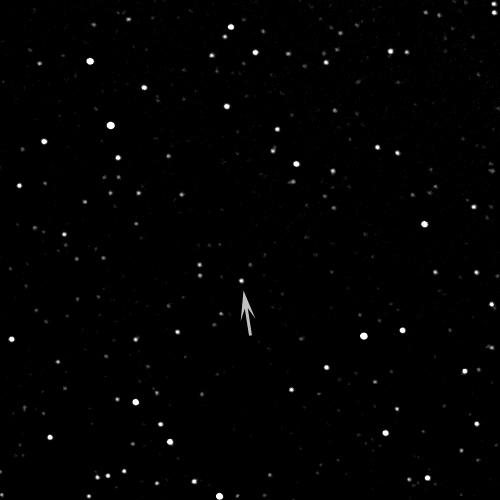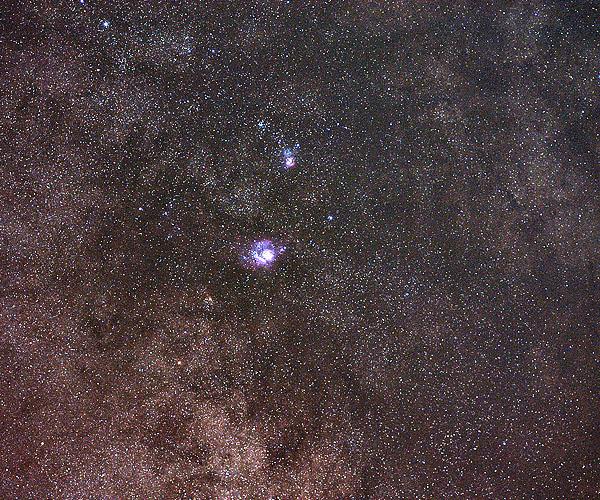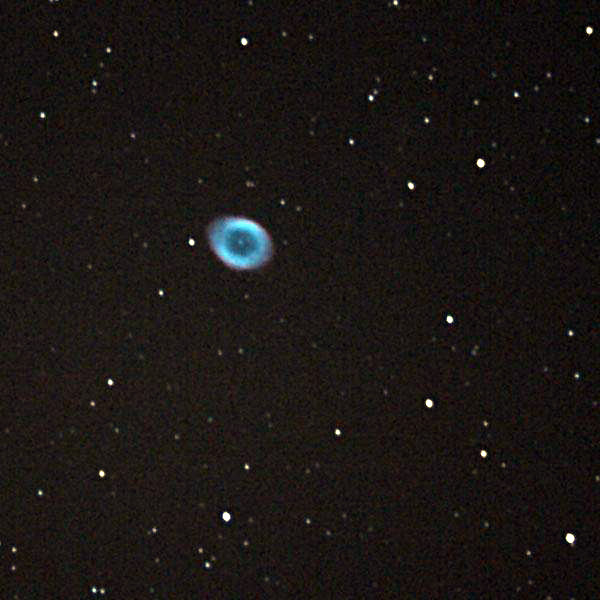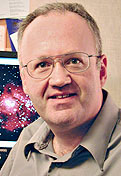 |
|
|
Popular topics on this page:  Did Bush destroy the World Trade Center? (Of course not.)
Did Bush destroy the World Trade Center? (Of course not.)
What will Mars do on August 27? Nothing!
Astrophotos:
Pluto
Lagoon Nebula
Ring Nebula
Trifid Nebula
Galaxy M51
 For more topics, scroll down, press Ctrl-F to search the page, or check
previous months.
For more topics, scroll down, press Ctrl-F to search the page, or check
previous months.
BOOK SALE - I'm selling off some scholarly books via Amazon Marketplace. Have a look!

|
2006
August
29-31
|
A 68HC11 Ghost Story
Today I matched wits with a truly unusual microcontroller problem in the
engineering course I was teaching.
The task was to implement a 4.1-millisecond delay loop.
Two students were testing this by toggling one output bit of Port A in between
invocations of the subroutine.
This should have produced a square wave with a period of 8.2 milliseconds,
observable on the oscilloscope.
Well... The top bit of Port A was actually delivering a 100-millisecond square wave,
or something of the sort. Way too slow.
Out of curiosity I looked at the rest of Port A. The second highest bit was toggling
twice as fast... and the next one twice as that... and so on through all five of the
bits that can be used as output.
Weird!
We double-checked everything. We moved the whole program to a different HC11,
a different PC,
and a different oscilloscope.
Still the same thing.
Obviously, some kind of clock or timer was being output through Port A.
Why, we couldn't imagine.
The solution?
Yes, I did crack the puzzle.
The answer was that
MiniIDE was
set up to assemble for the HC12, not the HC11.
The language is the same but the instructions are different.
I never actually found out what instructions were being given to the HC11.
But we set up MiniIDE to use the ASM11 assembler, not ASM12,
and sanity returned to our part of the world.
Note added Aug. 31: To be specific, what happened
was that the opcode for STAA #PORTA (store value in Port A) on the HC12 is the
same as DEC #PORTA (decrement number in Port A) on the HC11.
So we got a loop that counted down over and over, from 11111111 to 00000000 in binary,
rather than outputting the specified pattern.
Permanent link to this entry
Father Brown on line
G. K. Chesterton's Father Brown stories are
available on line here.
They are beautifully typeset in HTML (yes, it can be done!).
I'm going to spend the rest of the month reading them
rather than writing blog entries. See you September 1!
Permanent link to this entry


|

|
2006
August
28
|
A jug of what?

I think our grocer is trying to confuse us.
Permanent link to this entry


|

|
2006
August
27
|
Pluto is still there
This picture, which I took last night, makes it clear why
Pluto doesn't deserve to be called a planet.
It's the 14th-magnitude speck indicated by the arrow.

Reprocessed picture uploaded Aug. 27, 2:30 p.m. EDT.
Permanent link to this entry
Trifid Nebula
This is not a bad picture of M20 considering it was taken through murk;
I couldn't see stars fainter than third magnitude with the unaided eye.

Color-corrected picture posted December 20.
Permanent link to this entry
Still more folly
Fans of The Da Vinci Code have
vandalized a medieval church in England,
trying to break open a wall in which they thought the Holy Grail was hidden.
The Da Vinci Code is fiction, folks.
Permanent link to this entry


|

|
2006
August
26
|
Congratulations, Dr. Kwon!
Yesterday (Aug. 25), my graduate student Soyoung Kwon finished her doctorate.
That is, she completed the thesis defense, a procedure in which she gave a presentation
about her work and then answered questions from three professors while some guests
looked on. Congratulations!
Dr. Kwon's research consists of a new method of getting computers to recognize sentence
structure in Korean.
Her thesis will soon be available on line at the
University of Georgia Libraries;
an earlier paper about the same work is
here.
It's distantly derived from my work in the 1990s, including
this,
although she has simplified it a good bit by finding some restrictions on Korean word order
that allowed her to discard half of the search algorithm.
(No, I don't know Korean. Some linguists in Korea adapted my technique to their language,
largely without my knowing they were doing it.)
Today Dr. Kwon is off to Boston to start a job with Inxight.
Congratulations again!
Permanent link to this entry
A day of strange events
Many of today's news headlines look like they came from
News of the Weird, but no, they're from the
mainstream media.
A total of seven flights were diverted or delayed yesterday (that we know of)
due to security problems.
According to unconfirmed reports, these include
a student carrying a stick of dynamite in his luggage as a "souvenir,"
a 10-year-old boy who claimed to have a bomb because he didn't want to fly,
an airhead who insisted on using fingernail polish when directed to put it away
(since it's flammable),
and sundry mentally unstable people who scuffled with crew members.
This shows me how fragile airline safety has always been.
What will it take to get passengers to take safety seriously,
and especially to understand that they have no right to quarrel with the crew?
Samuel Johnson once said that being on a ship was like being in a jail,
but with a chance of drowning.
An airliner is like that — you're totally dependent on the crew,
and there's no room for troublemakers.
Meanwhile, a Jewish comedian in New York is
suing Jews for Jesus
for falsely describing him as a Christian in their literature.
What's weird about this is that the leaders of Jews for Jesus don't seem
to understand why he objects.
They say the false depiction was "good-natured."
Well... I know I wouldn't want to be publicly described as adhering to any
religion that I don't actually adhere to.
Also, I can understand why most Jews are put off by "Jews for Jesus."
I am always in favor of people becoming Christians, but I thought we settled it in
the first century, that when you accept Jesus your religion is no longer Judaism.
Finally, I bestow today's meta-confusion award (for confusion about confusion)
to News of the Weird Blog,
which pokes fun at an astrologer for remarking that the downgrading of Pluto
won't make any
difference to the way he tells fortunes.
Well... I think astrology is bunk, just like other forms of fortunetelling, but if astrologers
believe Pluto does have some influence on human events, then surely its reclassification
won't make any difference, and the astrologer is perfectly right!
Folks, they didn't take Pluto out of the sky this week, they just pinned a slightly different
name on it. But I expect more meta-confusion about Pluto.
Permanent link to this entry


|

|
2006
August
24-25
|
Miscellany
Maybe Pluto didn't lose fair and square:
The BBC reports
that the vote was "hijacked," since it was taken right at the end of the meeting, when lots of
people had left. Look for another vote soon.
Really good electronics site:
Buildinggadgets.com,
the home of
Electronics
Projects for Dummies (which just came out).
The author does some innovative things remininscent of
Alfred Morgan,
such as using solderless breadboards for semi-permanent construction.
Academia and God Forum: On October 6, I'll be speaking at
this.
Come one, come all!
Permanent link to this entry


|

|
2006
August
23
|
Miscellany
Minor corrections August 28.
Dubious achievement #1: A downtown Athens (Ga.) bar owner named his establishment "Detour,"
painted a realistic detour sign on the outside wall, and sent people the wrong way down a one-way
street. He got hit with a fine for that.
Dubious achievement #2: The University of
Georgia Athletic Association made students stand in line for several hours (missing classes)
a couple of days ago for a
chance to get football tickets.
A near-riot ensued when the delay was much longer than expected.
Students are already disgruntled because,
on football weekends, the Athletic Association rents all of the University's parking and
kicks the students out of most of it.
These students will soon be alumni, they won't attend football games, and the
whole enterprise may dry up.
Here
is a place where you can buy old-style pointy-tipped light bulbs to use in your antique lamps.
Have I mentioned the
Cingular Wireless FAQ
yet?
It's written by customers, not the company, and is very useful.
While I'm not much of a fan of country music, I don't want it
wiped out
in a movement to make radio stations all alike.
There is no longer a country radio station in all of Los Angeles!
At last, a discount software dealer
whose products are entirely legit (no violation or bending of licenses).
Has anyone dealt with edirectsoftware.com?
Are they as good as they look?
It reminds me of the way, in the 1980s, there was genuine price competition among software dealers.
Here
is how to remove rust by electrolysis.
Everybody with a collection of antique tools needs this!
Permanent link to this entry


|

|
2006
August
22
|
M51 reworked

Color-corrected picture posted December 20.
This is my picture of the galaxy M51 from
back in May,
reworked with MaxIm DL.
Not all the improvement is purely due to the software.
It's partly my increasing skill. I don't think I actually did
anything that couldn't have been done with ImagesPlus.
Permanent link to this entry


|

|
2006
August
21
|
Didn't know what I was missing
I'm glad to say my first evening with MaxIm DL + DSLR
was a great success.
This software gets a lot of little things right.
It's easy to work through the menus and process a picture.
The program remembers what directory I'm working in and what set of dark frames I've set up.
Each of the pictures you see below is a stack of a few 5-minute exposures with a Canon Digital Rebel
in raw mode (not JPEG compressed). The crucial step in processing is dark frame subtraction.
I took four 5-minute exposures with the lenscap on, to record the "hot pixels" (pixels that think
they're seeing light when they're not).
These dark frames are combined and then subtracted from each image.
I've been doing this all along, but tonight I did it before de-Bayerization.
That is, I did the dark frame subtraction before letting the software determine the color of each pixel.
With the Bayer system, every pixel is lightly filtered red, green or blue.
Each pixel knows its own brightness, but it must look at two of its neighbors in order to
compute its color. By doing the dark frame subtraction before this step, I get much more
accurate subtraction of low-level noise.
So here's the Lagoon Nebula, M8, and its neighborhood, through a 105-mm f/2.8 Sigma telephoto lens (at f/4):

Color-corrected picture posted December 20.
And here's the Ring Nebula, M57, taken through the 8-inch telescope at f/6.3:

Color-corrected picture posted December 20.
Both were taken on the evening of July 17 under surprisingly poor conditions.
Final processing, including some stretching and unsharp masking, was done with Photoshop CS2.
Permanent link to this entry


|

|
2006
August
20
|
Pluto — or maybe not
Latest word from the International Astronomical Union is that a surprising number of
astronomers see things my way and don't want to classify
Pluto as a planet after all — not now that it has been shown that Pluto is one of
a swarm of similar objects.
They're now considering a definition of "planet" that does require comparing an
object to its immediate neighbors before classifying it.
This is ultimately more useful, I think, because it takes more information into account,
but it's inconvenient for people who are discovering extrasolar planets one by one and
don't know what else is near them.
Permanent link to this entry
Astro-software
Scientific software, even when written by professional scientists, is often
amateurish in the bad sense — it fails to follow standards.
In particular, all too much amateur astronomy software fails to interact with the
user or the operating system in the normal way.
Obscure user interfaces abound, as do strange requirements, such as programs that
require administrator privileges for no good reason.
Consider, for example, software to process astronomical images from DSLR cameras
(including raw image files).
Last night I bit the bullet and bought
MaxIm DL + DSLR.
To my pleasant surprise, it has a straightforward, standard user interface.
I haven't put it through its paces yet, but nothing about it struck me as wrongheaded,
and that's a good sign.
Its leading competitor, ImagesPlus, is very powerful
and much less expensive, but its user interface is idiosyncratic.
At least in the version I'm using, which is not the latest,
it makes the Windows "error" noise to denote success, and it often fails to indicate whether an
operation has been performed. (Basic ergonomics: every action should produce a visible change on the screen.)
Besides, it requires that you run it with administrator privileges.
Despite these quibbles,
I've been using ImagesPlus for some time and getting very good pictures.
Then there's IRIS, which is free and looks like a
first-rate piece of software as long as you are willing to learn a user interface that
is all its own. Like some statistical packages, it has a command language, and the Windows
user interface is built on top of that.
I haven't used IRIS, but it may be the best image processor of the lot.
Both ImagesPlus and IRIS have good sets of tutorials available. With MaxIm DL,
the tutorials are available but are decidedly less necessary. I find that, if I know what I want to do,
figuring out how to do it isn't hard. That's a sign of good design.
Permanent link to this entry


|

|
2006
August
19
|
First cell phone camera photo
Here is the first actual photograph taken with my cell phone camera.
It's one of the University's flowerbeds, and the picture is composed to
take advantage of the extreme depth of field of the camera lens.
The nearest flower is less than 2 inches in diameter.
Specifications aren't given, but the lens looks like it's about 3 mm
in focal length, f/3.
The sensor must be 2×3 mm, and it's 480×640 pixels,
giving a pixel size of 1/240 mm = 4 microns.
With a sensor that small, you can apparently get decent depth of field
even at f/3.

It's slightly overexposed; I worked on it with Photoshop, but it still looks
a bit posterized. You're seeing it at about 2/3 of full size.
Permanent link to this entry
68HC11 tools
If you program the Motorola (Freescale) 68HC11 — as I do, in
a course
I'm teaching — then you need
MiniIDE, a very
promising freeware editor-assembler-downloader.
It certainly beats the DOS-based tools we originally had!
We're still testing it, and if there are any nasty surprises I'll say so.
But it looks like a fine piece of software.
Note also
EASIM, from Australia,
a Windows-based 68HC11 simulator, complete with "Griffalo"
(Griffith University's substitute for Freescale's BUFFALO loader).
Permanent link to this entry


|

|
2006
August
18
|
(Uploaded August 17. Read tomorrow's news today!)
Phone mystery resolved
 Actually, my new telephone can send e-mail, including picture attachments,
on a pay-per-use basis.
Actually, my new telephone can send e-mail, including picture attachments,
on a pay-per-use basis.
(Either this service wasn't available on the first day of activation, or I hadn't managed to kick the
keypad into alphabetic mode to type an address.)
Using e-mail from my phone, I was able to transmit to my computer this
picture of the 2004 lunar eclipse, which has adorned the face of several of our Samsung cell phones,
being passed from one to another by MMS, but until now, not sent to a computer.
It got into the phones in the first place through Cingular's Image Composer service,
where you upload and edit a picture.
It is one of my
lost 2004 astrophotos.
Presumably, I've had this capability for quite a while without knowing about it. It will give me a way to
download pictures taken with the phone camera while waiting for Bluetooth adapters to get cheaper.
Permanent link to this entry
Current events
The news media are so obsessed with JonBenet Ramsey, and the arrest in the long-standing
murder case, that they're ignoring other developments. Let me point a few of them out.
Yesterday a plane was diverted to Boston and we were given to understand that a passenger had had
a panic attack. CNN now reports
that the panicked passenger was a "peace activist" who had been
living in Pakistan and writing newspaper columns critical of the U.S. (both of which are perfectly
legal things to do — but the point is, it wasn't someone unaccustomed to traveling),
and that she quarrelled with the crew, made comments about Flight 93,
about having been in a country illegally, and apparently about al-Qaeda,
and urinated on the floor of the plane.
Also, the FBI confirmed what other sources denied yesterday, that she did have a screwdriver
and cigarette lighters in her carry-on baggage, objects which are not permitted, and that she
knew they were illegal.
In short, some caution was definitely in order and those jet fighters were not a
bad idea. This wasn't Granny having a panic attack, folks.
Note #1: All CNN news articles, as well as those on other
news sites, are revised frequently. By the time you read this, they may be quite different from
what I'm looking at now.
Note #2: All I know is what I read in the papers.
It is always possible that the facts are not reported correctly. Everyone is innocent until
proven guilty.
Also, as I write this,
an airport is shut down
in West Virginia because someone apparently tried to smuggle explosives on board a flight.
(New tactic: Enter the secure area at a small airport where security might not be as strict.)
I have no idea what will come of this.
We're not hearing a lot about these because of something the media consider far more important,
namely that a man allegedly claims to have killed JonBenet Ramsey.
The murder 10 years ago was a true tragedy, but it's very hard to tell what is going
to transpire next. Am I the only one who was rather put off by the parents' efforts to make this
6-year-old girl so attractive to adult men?
(I'm choosing my words carefully.)
She certainly seems to have had a following of middle-aged
male fans, including not only the alleged murderer, but also
a man we saw on TV who travels from West Virginia regularly to visit her grave even
though he never knew her personally.
Permanent link to this entry


|

|
2006
August
17
|
New cell phone...
 This picture of Saturn (which I took myself)
graces the screen of my new Samsung D407 cell phone. (The
blank brownish area at the top is for the date, time, and icons.)
This picture of Saturn (which I took myself)
graces the screen of my new Samsung D407 cell phone. (The
blank brownish area at the top is for the date, time, and icons.)
The way I got it there is fairly convoluted.
But first, I should congratulate Sharon for getting her driver's license two days ago;
then she needed a cell phone; we did a series of hand-me-downs; and I got a new one.
I'm too stingy to sign up for Internet access from my cell phone. I'm willing to use MMS (multimedia messaging)
on a pay-per-use basis. This allows me to exchange sounds and pictures with other phones.
It also enables me to send pictures from my PC to the phone using the address
xxxyyyzzzz@mms.mycingular.com where xxxyyyzzzz is my 10-digit phone number.
In that way I was able to edit the 128×156-pixel GIF image on my PC, then transmit it to the
telephone, save it, and set it as the background (wallpaper).
I should add that that e-mail address is heavily spam-filtered, as it should be.
It wouldn't even take messages sent from my home, where the "From:" address is Covington
Innovations but the actual outgoing server has to be the one associated with our
DSL line. From Cingular's point of view, this is a suspicious mismatch.
What I flatly can't do is send pictures from the phone to the computer,
apparently because I haven't subscribed to cell-phone Internet srevice.
That's a pity because the phone has a camera built in.
I'm going to get a Bluetooth adapter to link the phone directly to the computer.
Update: I was mistaken. My phone can send e-mail on a pay-per-use basis.
See the next entry.
Next trick is to get this cell phone
unlocked before the next trip to England,
if I can, so I can use it there. The local Cingular rep says flatly that they won't unlock it.
But it's a quad-band international model and I suspect I can either persuade them or get
the unlocking done by third party.
Permanent link to this entry
Is Pluto still a planet?
There's a resolution before the International Astronomical Union to
redefine "planet" so that Pluto will still be a planet — and so will the
asteroid Ceres and a couple of outer Kuiper-belt objects.
If the resolution passes, we'll have at least 12 planets right away.
That's not how I would have done it. The way I see it, we have inner planets
(Mercury, Venus, Earth, Mars) and outer planets (the gas giants, Jupiter, Saturn,
Uranus, and Neptune), as well as inner asteroids (Ceres and over twenty thousand of
her cohorts) and outer asteroids (in the Kuiper Belt). I would demote
Pluto to "outer asteroid" and go back to having 8 planets.
But I see where the IAU is coming from. They want to be able to
define "planet" without referring to any of the neighboring objects
because they're starting to discover planets around other stars, and they
have no way of knowing if other planets are in the neighborhood of each one.
(My system depends on putting each planet into a group.)
The IAU criteria are that a planet: (1) is not a star; (2) orbits a star; and (3) is round
(that is, its gravity is strong enough to pull it into a spherical shape; irregularly-shaped
rocks are not planets).
And it happens that one member of the inner asteroid belt, namely Ceres, and a few members
of the Kuiper belt meet these criteria.
Permanent link to this entry


|

|
2006
August
14-16
|
A novel in familiar surroundings
Last night (Aug. 14), I enjoyed reading, at one sitting, a classic English detective
story called
Avenging Angel, by Anthony Appiah.
The story is set in
Clare College, Cambridge
(part of Cambridge University) around 1980.
The author was a student there at that time.
And so was I (1977-78 only). So I had the odd, but enjoyable, experience of reading a novel set in very
familiar surroundings.
I didn't recognize myself as a character, thank goodness.
In fact, much of the story revolves around a semi-secret society, the Cambridge Apostles,
that was entirely different from the set of people I associated with.
Which is just as well, considering some of their antics.
But the book was in some ways a trip down memory lane.
Much of the action took place within a few yards (not miles, yards) of where I lived,
in Thirkill Court.
Even the Phoenix operating system
— which was Cambridge's quaint contribution to IBM mainframe computing —
figures in the story.
Anthony Appiah is not just a novelist; he is actually a noted philosopher from Ghana.
I didn't know him at Cambridge but had the pleasure of meeting him a couple of years later,
when we were both graduate students at Yale.
Permanent link to this entry


|

|
2006
August
13
|
Death of a trademark

A familiar sight at every electronic parts store in my youth was the blue-and-orange Belden wire reel,
which had exactly the same design whether it was two inches across or ten.
Manufacturers rely on distinctive trademarks and packaging — or, as they call it, trade dress —
to make their products recognizable. There's Kodak yellow, Campbell's Soup
red and white, and the distinctive shape of the Pringle's can.
So I have been surprised by the way Belden abandoned this distinctive design,
fiddled with several others, and ended up with no trade dress at all.
Here are some spools of Belden wire dating from 1967, 1978, about 1985, and 2006:

Note the complete lack of consistency. This is not a complete set; there was also a
red-and-white one, but I happened not to buy any Belden wire during its short heyday.
And note that the last reel, bought a couple of days ago at Ack in Atlanta, has
no trademark at all.
It's just a white label. The green seal is not Belden's;
it's a certification that the wire is lead-free.
Permanent link to this entry
Short notes
Kodak has come out with a product we really need —
archival CD-R discs.
I want some! They cost about $1.50 per disc in quantity, which is as much as 10 times the cost of the cheapest discs,
but not unaffordable.
Some time back I mentioned fake induction-powered flashlights (you shake them to make them work, but it's not
really a magnet and coil supplying the power, but a hidden battery).
Here is a detailed
teardown of one. Of course, real induction-powered flashlights do exist and are very handy, but they cost a lot more
than 99 cents.
It's conceptually straightforward, but mathematically difficult, and somebody finally done it:
computer
deblurring of pictures smeared by camera motion.
In principle, any defect in an image can be corrected if you still have all its effects (nothing fell outside the frame of the picture
or outside the brightness range that the camera can record) and if you know exactly what
the defect was. Astronomers do this routinely by analyzing a star image (since stars are perfect point sources) to find out,
and then remove, the optical flaws in an image. Removing the effect of camera motion is a similar problem; the challenge is to
scan the image and get an accurate idea of exactly how much smear needs to be removed, and in what direction.
Permanent link to this entry


|

|
2006
August
11-12
|
Are terrorists and saboteurs winning?
Jeff Duntemann
opines
that yesterday's terrorist attack on airliners two days ago,
even though seemingly foiled, was
actually a success in that it has ended the
era of easy and comfortable air travel.
That may be an overstatement, but if every terrorist threat takes away more of my
freedom, who's really winning?
The same goes for cybercrime, everything from identity fraud to phishing to spamming.
Basic laws of the land are not being enforced on the Internet.
Never mind the CAN-SPAM act; almost every spammer is violating pre-existing laws,
such as illegal sale of prescription drugs, illegal manipulation of the stock market,
or just plain misrepresentation.
And it's the victims who are expected to give up freedom and convenience
and spend their own money on defensive software and hardware.
Why not make life hard for the perpetrators for a change?
I'm in favor of a tax on the Internet if it's used to pay for law enforcement.
Fifteen years ago, before the Internet, it was common for an ordinary American to go for months
if not years without anyone attempting a crime against him.
Now would-be criminals are hitting on me 200 times a day.
Some of them must be easy to catch.
Enough of this "electronic frontier." I want civilization!
We also need to take seriously the fact that cybercrime is a matter of national security.
It's exactly the kind of thing an enemy would do to weaken our economy.
Permanent link to this entry
End of an era
I must have been the last to find out... the big Wolf Camera store on 14th Street in Atlanta,
the flagship of photography in the South for the past twenty years, has closed.
Or rather moved to Buckhead. I wonder how much traditional (non-digital) photography moved with it.
The funny thing is, I drove right past it two days ago and almost stopped by.
I didn't even notice that it was vacant.
That's where I bought my telescope in 2000, and some of my astrophotos were, as of a few
weeks ago, still on display there.
Speaking of camera stores of the past, one of my astrophotos had the honor of being displayed
at Spiratone in Manhattan around 1987, in Spiratone's last days. Their 300-mm f/5.6 mirror lens
was sharp, though it sometimes gave me trouble with internal reflections.
Permanent link to this entry


|

|
2006
August
7-10
|
Short notes
I'm still alive, but very busy, so this will be a short entry.
Mid-20th-century electronics: While in Atlanta yesterday I stopped in at
Ack Radio, which has changed little since the 1960s
except that the shelves are stocked with modern merchandise. (Well, mostly.)
Look at their web site. If you were involved in electronics 40 years ago
(and I hasten to add that I was, as a very young boy), then it will bring back memories.
The real bargains, though, are at Austin Electronics,
whose showroom is full of bins of surplus parts.
Free C for the AVR: Here
is a guide to using AVR-GCC, the free C compiler for the Atmel AVR microcontroller.
Nikon D80: If you read French, click here.
Nikon may be retaking the lead (vs. Canon) in the low-cost DSLR business. I'm going to test one of these for astrophotography very soon.
DSLR book:
I've started work on a book about
astrophotography with DSLR cameras.
You heard it here first, if you read down to the bottom of this boring blog entry!
Permanent link to this entry


|

|
2006
August
6
|
An Atmel AVR notebook
I spent the weekend learning how to program
Atmel AVR
microcontrollers (in 3 different programming languages)
and produced
these notes.
Permanent link to this entry
Congratulations, Dr. Fjordbak!
The other thing we did this weekend was celebrate the graduation of Bess Fjordbak,
Ph.D. in linguistics. She and her husband hosted a luncheon after the graduation ceremony.
I did not actually direct Bess's dissertation, but she was a very
valuable member of my CASPR
research group, and now she's on the way to the University of Texas at El Paso.
Permanent link to this entry


|

|
2006
August
5
|
Notes from all over
Stephen Bainbridge
blogged
a facetious report from
The Onion about how
President Bush supposedly granted himself the ability to increase his powers...
...and he got some quite serious comments from concerned citizens who
didn't realize that, like everything else published in The Onion,
this was a joke. Unless, of course, the commenters were entering into the
spirit of the joke and failing to be funny.
Michael Holley is keeping
Popular Electronics and Radio-Electronics Magazines alive,
at least in our memories, by digitizing and preserving classic material.
It's all on the up-and-up; he's in touch with Poptronix, which acquired all the copyrights from
Ziff-Davis and Gernsback long ago.
I had great fun writing articles for Popular Electronics when it was run by Gernsback in the 1990s
and was sad to see it go. I enjoy browsing through my collection of early issues from the 1950s.
The Wire Recorder Project
is an interesting account of how someone restored a vintage wire recorder to life in order to play
and copy some old recordings. Wire recorders, you'll recall, preceded tape recorders; they recorded
magnetically on steel wire. Tape is better, but any magnetizable medium can be used;
in one episode of
The Secret Life of Machines,
a snippet of audio was recorded on the moving blade of a bandsaw!
Permanent link to this entry


|

|
2006
August
4
|
What will Mars do on August 27? Nothing!
Somebody is spreading the
August 27 Mars hoax
again, this time with this year's date in it.
Mars will not look "as big as the moon" on August 27.
It can't; it doesn't get that close.
(Remember, Earth and Mars both orbit the sun in nearly circular orbits.)
In fact, this month Mars is far away, on the other side of the Solar System.
It did come about as close as it possibly can on August 27, 2003,
but at the time, it just looked like a bright reddish star.
What alarms me about this instance of the Mars hoax is that it came
to me by way of a high-school science teacher.
Permanent link to this entry
India's sunny clime
 Sharon has just returned from a 2-week school trip to India, where she helped
repair a computer network at a school in Pallam that had been hit by the tsunami.
She also did many other marvelous things, including meeting the
President of India
(an extraordinary man) and attending part of a session of Parliament.
Of course she also saw the Taj Mahal, Fatehpur Sikri, and many other fascinating
places.
Sharon has just returned from a 2-week school trip to India, where she helped
repair a computer network at a school in Pallam that had been hit by the tsunami.
She also did many other marvelous things, including meeting the
President of India
(an extraordinary man) and attending part of a session of Parliament.
Of course she also saw the Taj Mahal, Fatehpur Sikri, and many other fascinating
places.
This morning she had a layover in Paris, De Gaulle Airport
(which she describes as a Habitrail),
and bought me a souvenir — a copy of the French photography
magazine Déclic Photo.
The French publish excellent reviews and tests of digital cameras;
so do the Spanish, as I learned when Cathy brought me a copy of
Super Foto from Ecuador last month.
Incidentally, I consider De Gaulle Airport to be one of the world's worst pieces of
architecture. To my surprise, no pictures showing its unique structure are on the Web,
but Sharon's "Habitrail" metaphor is right on target.
Photography there is heavily restricted and rightly so — the whole thing would be
very easy for a terrorist to destroy.
Part of it collapsed on its own two years ago, killing four people.
Permanent link to this entry


|

|
2006
August
3
|
More free C and other good PIC news
A few days ago I was writing about
the new low-end PIC microcontrollers.
Today my
PICkit 2 arrived — that's the under-$50 development system —
along with a goodly quantity of low-end PIC microcontrollers. I set to work immediately trying it out.
I'm going to rebuild my "Astronomical Egg Timer," a gadget that times 3-minute exposures
on my Canon DSLR.
The PICkit 2 works very well. It's USB-attached and requires no other power source.
It even has the presence of mind not to disturb the oscillator calibration numbers
of the PIC12F508 and its kin.
Although I had no problems, I went to Microchip's web site
to see if there were newer releases of the software. Indeed there were.
Since the PICkit was built (2 months ago), there's a new release of MPLAB (7.41) and a new release
of the PICkit software and firmware (both 1.21).
So I installed them.
Pleasant surprises:
- Very good instructional materials come with the PICkit-2 (on disc). You can learn a lot
about microcontroller programming from them.
- Yet another C compiler is available free of charge. The
CCS PCB C Compiler
is now (as of version 7.41) supplied with MPLAB.
This is only for the "baseline" 12-bit microcontrollers, including the super-low-cost PIC12F508.
For mid-range PIC microcontrollers, there's still
HITECH PICC-Lite,
also integrated with MPLAB.
Unpleasant surprises:
- MPASM still limits you to 62 characters in the full path to the file to be assembled!
This is a DOS limitation that predates Windows 95, and it really isn't compatible
with modern life. By the time you've said
C:\Documents and Settings\John Q. Developer\My Documents\PIC
you've used up your limit and you haven't even given a filename yet!
(Incidentally, Windows Vista helps with this a little. In Vista, I'm told that it comes out as
C:\Users\John Q. Developer\Documents\PIC
which is shorter and makes it possible to avoid having spaces in the path, if the
user name does not contain spaces.)
I started
a discussion about this.
(And look at the response I got. Lots of misinformation about Windows
and lots of advice mildly criticizing me for
wanting to use Windows in the normal manner. I'm dismayed.)
Update: The 62-character limit resides in the .COD file format
still (by default) used by MPASM and MPLINK, not in legacy DOS code.
To work around it, you have to add a linker script (.lkr file, from the templates provided
with MPASM Suite) to your project; then the linker works in a different mode and does not have
to produce a .COD file. It may still try and fail to do so, and if you wish, you can turn
off .COD file generation in Project, Build Options.
- MPLAB still requires you to have write permission in
C:\Program Files, which users of a properly secured Windows system don't have.
- The user doesn't have a choice whether to install MPLAB or PICkit on the program
menu of one user or of
all users. MPLAB 7.40 installed for one user; MPLAB 7.41 installed for all users;
PICkit 1.20 and 1.21 installed for one user.
- PICkit isn't integrated with MPLAB. (Later on, it's apparently going to be.
And right now, it is, if you're using a PIC16F917. What's unique about the
PIC16F917, I wonder? This is not the chip that comes with the PICkit 2; that's
a PIC16F690. And the '917 doesn't even fit in the demo board that comes with
the PICkit 2; you have to build your own circuit board for it. Hmmm...???)
More news as the adventure continues. I'm particularly interested in using C on tiny processors.
At that level, C is hardly more than a macro assembler, but it should add some much-needed
readability to the programs.
Permanent link to this entry


|

|
2006
August
1-2
|
Did Bush destroy the World Trade Center with military aircraft?
(Of course not!)
Apparently, 9/11 conspiracy theories
have taken in
a noted Presbyterian writer
(who is no authority on world affairs).
If it were true that the Bush administration (not the Arabs) caused the 9/11 attacks,
it would be horrible to contemplate.
An American president slaughtering 3,000 of his own civilians in order to make an excuse
to go to war?
Not plausible. Remember that numerous presidents have gone to war without needing any
domestic crisis as an excuse. (Including the elder Bush.)
Isn't it less risky to just go to war, than to first attack your own country and then go to war?
Anyhow, consider the number of people that would have to cooperate in such a conspiracy
in order to carry it out and then conceal it.
I just don't think American politics is capable of that degree of secrecy. We've had a tradition
of open government since the Magna Carta.
What's most important about these conspiracy theories is that they contradict each other
and do not seem, as a whole, to point anywhere.
It's not like the Kennedy assassination, where there was lots of circumstantial evidence
that Oswald didn't act alone, and he was killed before he could tell his story.
It's more like trying to say that Kennedy was never assassinated.
See for example
this detailed refutation
of many of the conspiracy theorists' divergent claims.
Apparently, they're quite good at resorting to outright fabrications
in order to tell a good story.
Behind this are two points to appreciate.
The first is moral:
It is wrong to accuse people of serious crimes without good evidence,
and it is wrong to knowingly make people believe falsehoods
in order to enrich yourself as a writer or talk-show host.
The second is a point of logic:
You can believe anything, in the face of any evidence,
if you are willing to hold enough other strange beliefs.
(I think it was Quine who most clearly pointed this out, a few decades ago.)
For example, you can believe there is no such place as New York City
if you are willing to believe that the millions of people who claim to have
been there are all lying or deluded.
Permanent link to this entry
Tech notes
PIC hint:
The fine folks at
PIClist
point out that you can find lots of PIC assembly-language programs
by Googling for MOVLW,
which is an assembly-language instruction
distinctive to the PIC.
Video editing in C# and .NET:
I've been working on a program that has to do some video editing and have found
DirectShowNET.SourceForge.net
very helpful. This open-source (LGPL) package completely insulates you from COM programming.
And here
is an excellent (earth-based!) picture of Jupiter's
two Red Spots.
Permanent link to this entry
Economic notes
I think the interest
rate on Series I savings bonds
will go up sharply on November 1, the next time the rate is set.
You'll recall that it is
very low right now
but was
high (6.93%)
during the previous 6-month period.
The reason is the we have some catching up to do.
The interest rate is linked to inflation.
What drove the rates up, 2 periods back, was the spike in fuel prices from Hurricane Katrina.
Then fuel prices fell, causing a brief deflation, followed by some inflation
that just made up for it.
Well... According to InflationData.com,
the inflation rate is back up.
The I-bond rate is about a percentage point higher than the annualized inflation rate measured from the
CPI-U every September and March.
Well...
CPI-U Change Annualized
Mar 2005 193.3
Sep 2005 198.8 +2.85% +5.77%
Mar 2006 199.8 +0.50% +1.01%
Now (June) 202.9
Sep 2006? 205.0? +2.60% +5.27%
Draw your own conclusions. Note by the way that annualization is like compound interest,
so annualizing a 6-month change slightly more than doubles it.
Speaking of economics,
Stephen Bainbridge opines
that the minimum wage should be indexed to inflation
and
lower for people who have not finished high school.
The first of these is obviously a good idea.
The rationale for the second is that a large proportion of minimum-wage workers
are high-school students working part-time for extra income, not people who actually
need a living wage.
Permanent link to this entry


|

|














 Actually, my new telephone can send e-mail, including picture attachments,
on a pay-per-use basis.
Actually, my new telephone can send e-mail, including picture attachments,
on a pay-per-use basis.
 This picture of Saturn (which I took myself)
graces the screen of my new Samsung D407 cell phone. (The
blank brownish area at the top is for the date, time, and icons.)
This picture of Saturn (which I took myself)
graces the screen of my new Samsung D407 cell phone. (The
blank brownish area at the top is for the date, time, and icons.)


 Sharon has just returned from a 2-week school trip to India, where she helped
repair a computer network at a school in Pallam that had been hit by the tsunami.
She also did many other marvelous things, including meeting the
Sharon has just returned from a 2-week school trip to India, where she helped
repair a computer network at a school in Pallam that had been hit by the tsunami.
She also did many other marvelous things, including meeting the